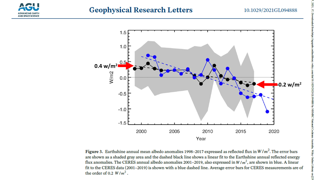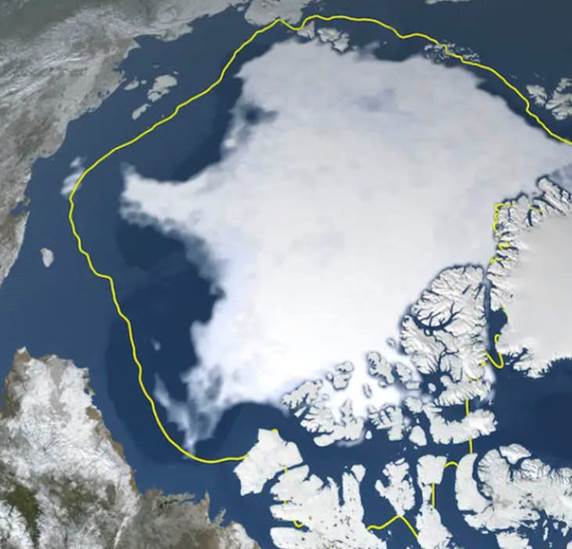Paper for AGU 2022 on planetary restoration
John Nissen
Cl...@endorphinsoftware.co.uk
--
You received this message because you are subscribed to the Google Groups "Healthy Planet Action Coalition (HPAC)" group.
To unsubscribe from this group and stop receiving emails from it, send an email to healthy-planet-action...@googlegroups.com.
To view this discussion on the web visit https://groups.google.com/d/msgid/healthy-planet-action-coalition/CACS_FxqBAiu8%3DdUv6ZJVEJqrYuBfJ-u2AZuD9Czs5MRdf-f_Bg%40mail.gmail.com.
For more options, visit https://groups.google.com/d/optout.
John Nissen
Hi Clive,
I didn’t want to raise the Ellis paper [1] as regards Milankovitch cycles and the time between the deglacial periods, which extended from 41 kyr (obliquity driven) for about 100 cycles at the beginning of the Quaternary Period to around 100 kyr (eccentricity driven) for the past 10 cycles. It is a complex issue, not germane to my AGU paper, and their paper puts forward a novel theory which I don’t personally accept. However your point about dust reducing albedo and helping to take the planet out of a glacial maximum is well taken. I had left a query in my version 3 and this paragraph should be modified to include this point and Arctic feedbacks which I’d omitted.
From version 3
At the depth of glacial periods, oceans are cool and the CO2 level declines. One theory is that, at around 185 ppm, the decline was sufficient to produce die-off in forests and grasslands, releasing CO2 and methane into the atmosphere as a negative feedback to the cooling. The low temperature certainly results in arid conditions and more dust being blown onto the oceans, which increases productivity but possibly has a positive feedback to the cooling [?].
For version 4
At the depth of glacial periods, oceans are cool and the CO2 level declines. One theory is that, at around 185 ppm, the decline was sufficient to produce die-off in forests and grasslands, releasing CO2 and methane into the atmosphere as a negative feedback to the cooling. The low temperature certainly results in arid conditions and more dust being blown onto the oceans, which increases ocean productivity. But the dust could also land on snow and ice, reducing albedo and warming the planet. According to one theory this effect would have been strong enough to take the planet out of a glacial maximum. It is well accepted that dust and ashes from super-volcanoes would have been sufficient to take the planet out of a snowball state. Currently we are seeing a dangerous reduction in Arctic albedo due to dust and soot from wildfires and tundra fires which have increased due to extremes of hot and dry weather. This is a strong positive feedback to Arctic amplification. The release of methane and exogenous heat from thawing permafrost is another.
Note that I bring in permafrost feedback as well as dust feedback both of which I’d omitted from version 3.
Cheers, John
[1] Ellis and Palmer (Geoscience Frontiers, 2016)
Modulation of ice ages via precession and dust-albedo feedbacks
https://www.sciencedirect.com/science/article/pii/S1674987116300305
Highlights
• The primary forcing agent regulating ice-age glaciation is precession.
• The primary feedback system regulating ice-age glaciation is albedo.
• Albedo modulation is controlled by desertification and dust contamination of ice sheets.
• Desertification and dust productions are caused by low CO2 concentrations.
Abstract
We present here a simple and novel proposal for the modulation and rhythm of ice-ages and interglacials during the late Pleistocene. While the standard Milankovitch-precession theory fails to explain the long intervals between interglacials, these can be accounted for by a novel forcing and feedback system involving CO2, dust and albedo. During the glacial period, the high albedo of the northern ice sheets drives down global temperatures and CO2 concentrations, despite subsequent precessional forcing maxima. Over the following millennia more CO2 is sequestered in the oceans and atmospheric concentrations eventually reach a critical minimum of about 200 ppm, which combined with arid conditions, causes a die-back of temperate and boreal forests and grasslands, especially at high altitude. The ensuing soil erosion generates dust storms, resulting in increased dust deposition and lower albedo on the northern ice sheets. As northern hemisphere insolation increases during the next Milankovitch cycle, the dust-laden ice-sheets absorb considerably more insolation and undergo rapid melting, which forces the climate into an interglacial period. The proposed mechanism is simple, robust, and comprehensive in its scope, and its key elements are well supported by empirical evidence.
You received this message because you are subscribed to the Google Groups "NOAC Meetings" group.
To unsubscribe from this group and stop receiving emails from it, send an email to noac-meeting...@googlegroups.com.
To view this discussion on the web visit https://groups.google.com/d/msgid/noac-meetings/236974076.684304.1669587733415%40email.ionos.co.uk.
John Nissen
Some comments
To view this discussion on the web visit https://groups.google.com/d/msgid/noac-meetings/CACS_Fxq9_85mBW98qkCQm%2Bggvretvapmahb7_2T_3dPQ7Boy%3Dg%40mail.gmail.com.
John Nissen
Hitherto, the idea of SAI has been met with extreme scepticism by the scientific community. Our examination of the evidence finds that SAI is potentially benign. A realistic reassessment is urgently required, since calculations may find that SAI is the only cooling technique with enough power to refreeze the Arctic.
There is much scientific work still to be done with no time to lose: in assessing cooling power requirements, in validating the expected Brewer-Dobson circulation at high latitudes, in modelling to assess optimum deployment, in designing trials, in monitoring, and in ensuring early detection of side-effects.
Here's the conclusion:
Our vision is of the Arctic
refrozen, climate change reversed, sea level rise slowed and the whole planet restored
to a healthy state by 2050. Through an
understanding of Earth system operation and the efficacy of cooling technology,
we believe such restoration is possible and should be demanded by the scientific
community. Such an ambitious endeavour
will require unprecedented global collaboration. But a safe, sustainable and productive planet
is what everyone must want for their children and grand-children.
Cheers, John
John Nissen
Hi Robert,
Perhaps there needs to be “Summary for policy makers” at the beginning of the paper, as IPCC have for their reports. But for the time being, I’ll add some text to a separate window on the poster form, entitled “Significance for policy makers and scientists”.
For policy makers:
- Achieving net zero by 2050 will not prevent dangerous climate change and sea level rise – the reduction in SO2 emissions from decarbonisation will make matters worse.
- Rapid Arctic warming, not global warming, is causing the dramatic increase in extremes of weather and climate as seen in many countries including the USA.
- These extremes are escalating the damage, loss of life and economic woes around the world, far beyond anything anticipated by IPCC economic models.
- Arctic warming is also accelerating the melting of the Greenland Ice Sheet, with risks of sudden sea level rise from its partial collapse.
- The immediate priority for climate action must be to halt Arctic warming.
- This necessarily involves a type of cooling intervention called Solar Radiation Management (SRM) of which Stratospheric Aerosol Injection (SAI) is a prime example.
- SAI shows promise of benign intervention sufficiently powerful to refreeze the Arctic.
- There is no time to lose: preparation for small-scale deployment of SAI should start immediately whilst validating the method and evaluating its efficacy at full scale. Other cooling methods should be supported as a back-up.
- Emissions reduction, even with large-scale CO2 removal (CDR), cannot provide the necessary cooling power in the necessarily short timescale.
- Industries keen to exploit a melting Arctic must be persuaded that refreezing the Arctic is in everyone’s best interest.
For scientists:
- Understanding the way the Earth System amplifies Milankovitch signals is vital for staving off climate catastrophe.
- Humanity’s huge pulse of greenhouse gases is simulating a peak Milankovitch signal and the Earth System is responding accordingly by amplifying this signal using albedo positive feedback in the Arctic.
- Arctic amplification causes climate change through a chain of effects:
- Arctic amplification reduces the temperature gradient between the Arctic and tropics, therefore reducing the energy which drives jet stream waves eastward round the planet.
- The Northern Hemisphere jet streams are meandering more to north and south, and are increasingly liable to get stuck in blocking patterns.
- This jet stream behaviour is causing a trend towards ever more extreme weather and climate.
- Arctic amplification accelerates sea level rise:
- The rapid Arctic warming is accelerating the melting of the Greenland Ice Sheet, contributing significantly to sea level rise.
- The ice sheet is showing signs of disintegration which could cause sudden collapse.
- Rapid changes in climate and sea level have occurred in the past and would be catastrophic for humanity today.
- To stave off catastrophe, the Arctic needs to be quickly refrozen.
- SAI can be applied quickly, cheaply and benignly to refreeze the Arctic.
- Emissions reduction and CDR, though desirable for long-term climate stability, cannot possibly provide the required cooling power on the required timescale.
Cheers, John
Rebecca personal em
You received this message because you are subscribed to the Google Groups "Planetary Restoration" group.
To unsubscribe from this group and stop receiving emails from it, send an email to planetary-restor...@googlegroups.com.
To view this discussion on the web visit https://groups.google.com/d/msgid/planetary-restoration/CACS_Fxq%3DRDUuNNAbaazhdq-LnGN_7mwBgoVhmzpNpvraW%2BDY7Q%40mail.gmail.com.
John Nissen
Now that the climate crisis is recognised as a real threat to humanity, not just to the poorer countries, there may come a recognition that powerful SRM has to be accepted, so there needs to be a decent risk assessment. The biggest risks from MCB and SAI are not from side-effects but that the method may not be sufficiently scalable to meet the cooling requirements. I claim that this risk is much higher for MCB than for SAI. But we do not have definitive figures about the cooling requirements for refreezing the Arctic.
Douglas Grandt
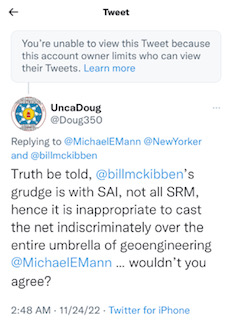
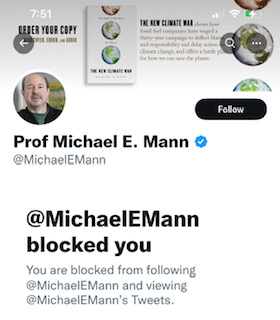
Because I’m fatigued typing on my phone with one fat finger …


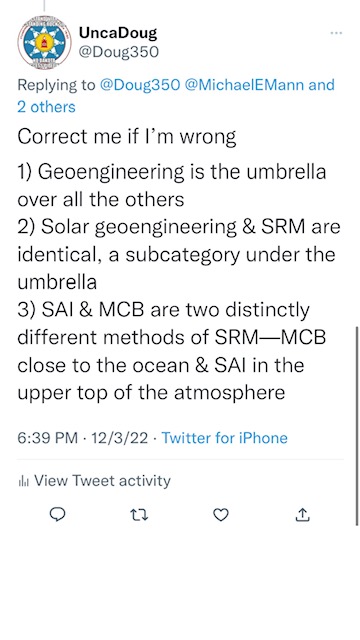
On Dec 3, 2022, at 6:20 PM, John Nissen <johnnis...@gmail.com> wrote:
To view this discussion on the web visit https://groups.google.com/d/msgid/planetary-restoration/CACS_Fxq0W8QnrOyshJuWNS55jn%3DzcD_y6Hg7nzZuj1%3DL4R-pMw%40mail.gmail.com.
rob...@rtulip.net
John
Here is a theme you might like to mention in your AGU summary – net zero heating.
Net zero heating is a better goal for climate stability than net zero emissions. A stable climate is one where cooling balances heating, against the primary measure of watts per square metre of radiative forcing.
Albedo Enhancement provides far quicker, easier, cheaper and safer cooling than GHG reduction. Therefore the cooling side of the net zero heating ledger is better achieved through a focus on increasing planetary radiation of heat and light back to space. Until we achieve net zero heating as a primary objective of climate policy, the planet faces massive risk of climate instability. A focus on GHGs is simply too slow, risky and expensive to deliver NZH.
Sustaining net zero heating requires ongoing regulation and management of the planetary climate. As a goal, net zero heating against the preindustrial Holocene base has the advantage over net zero emissions of producing Earth System Stability with our current sea level, while also mitigating all the climate tipping points now in operation.
Understanding the relative scale and timing of optimal climate actions requires that we put albedo first, recognising that carbon-based methods are too small, slow and contested to have major cooling impact, whereas albedo-based methods can readily achieve net zero heating within this century.
Regards
Robert Tulip
To view this discussion on the web visit https://groups.google.com/d/msgid/planetary-restoration/8DEF00EC-18F7-4A75-A4B4-546B52B09A7B%40gmail.com.
rob...@rtulip.net
2022 Arctic sea ice minimum, compared to average 1980-2010.
Clear picture of albedo loss. All the blue inside the yellow line used to be white.
https://climate.nasa.gov/news/3213/2022-arctic-summer-sea-ice-tied-for-10th-lowest-on-record/
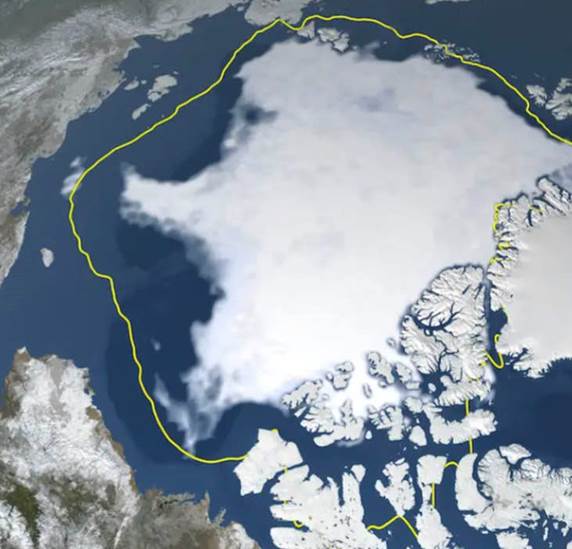
Robert Tulip
peterlin...@gmail.com
It’s perhaps not as obvious from the graphic, but the NASA figures indicate that although “only” the 10th lowest area, this summer’s coverage has fallen to 75% of the average for the 30 years to 2010. A reduction of 25% in 12 years is striking – and given the pre-1980 warming, this 30 year average is presumably a smaller area of coverage than a century ago.
Peter
--
You received this message because you are subscribed to the Google Groups "Planetary Restoration" group.
To unsubscribe from this group and stop receiving emails from it, send an email to planetary-restor...@googlegroups.com.
To view this discussion on the web visit https://groups.google.com/d/msgid/planetary-restoration/01cd01d9078a%2487f1c3b0%2497d54b10%24%40rtulip.net.
peterlin...@gmail.com
Robert
I agree that Net Zero Heating is a concept and catch phrase that could be a very useful alternative to the ubiquitous Net Zero Emissions. Its meaning is clear and it logically leads to the question of how it might be achieved – and that GHG reduction is only one of a suite of essential strategies. And it seems to me that the term Albedo-Based Cooling would follow as a very clear response once people get their heads around Net Zero Heating.
Peter
From: planetary-...@googlegroups.com <planetary-...@googlegroups.com> On Behalf Of rob...@rtulip.net
To view this discussion on the web visit https://groups.google.com/d/msgid/planetary-restoration/00c801d90781%248fff7740%24affe65c0%24%40rtulip.net.
John Nissen
John Nissen
To view this discussion on the web visit https://groups.google.com/d/msgid/planetary-restoration/026a01d90796%243868a050%24a939e0f0%24%40gmail.com.
John Nissen
Forecasts by economists of the economic damage from climate change have been notably sanguine, compared to warnings by scientists about damage to the biosphere. This is because economists made their own predictions of damages, using three spurious methods: assuming that about 90% of GDP will be unaffected by climate change, because it happens indoors; using the relationship between temperature and GDP today as a proxy for the impact of global warming over time; and using surveys that diluted extreme warnings from scientists with optimistic expectations from economists.
Nordhaus has misrepresented the scientific literature to justify using a smooth function to describe the damage to GDP from climate change. Correcting for these errors makes it feasible that the economic damages from climate change are at least an order of magnitude worse than forecast by economists, and may be so great as to threaten the survival of human civilization.
John Nissen
PR CARTER
To: "Robert Tulip" <rob...@rtulip.net>
Cc: "Planetary Restoration" <planetary-...@googlegroups.com>, "'Eelco Rohling' via NOAC Meetings" <noac-m...@googlegroups.com>, "healthy-planet-action-coalition" <healthy-planet-...@googlegroups.com>, "Peter Wadhams" <peterw...@gmail.com>, "Clive Elsworth" <Cl...@endorphinsoftware.co.uk>, "Shaun Fitzgerald" <sd...@cam.ac.uk>, "Gernot Wagner" <Ger...@gwagner.com>, "Douglas MacMartin" <dgm...@cornell.edu>, "Rafe Pomerance" <rafe.po...@gmail.com>, "Graeme Taylor" <gta...@bestfutures.org>, "Ye Tao" <t...@rowland.harvard.edu>
Sent: Tuesday, December 6, 2022 2:23:54 PM
IPCC expert reviewer
Co-author2018 Unprecedented Crime: Climate Science Denial and Game Changers for Survival
rob...@rtulip.net
Hi John
Planetary insolation averages 341 w/m2 of which about 100 w/m2 is reflected back to space, due to planetary albedo of 0.3 (source).
That means at planetary scale the percentage loss of albedo equals the loss in watts per square metre.
The chart below shows planetary albedo loss trend of 0.6 w/m2 (0.6%) this century from Earthshine data, and 1.4 w/m2 (1.4%) from satellite data (CERES). (source)
Pistone et al found that the Arctic planetary albedo decreased from 0.52 to 0.48 between 1979 and 2011, corresponding to an additional 6.4 ± 0.9 W/m2 of solar energy input into the Arctic Ocean region since 1979. Averaged over the globe, this albedo decrease corresponds to a forcing that is 25% as large as that due to the change in CO2 during this period.
Robert
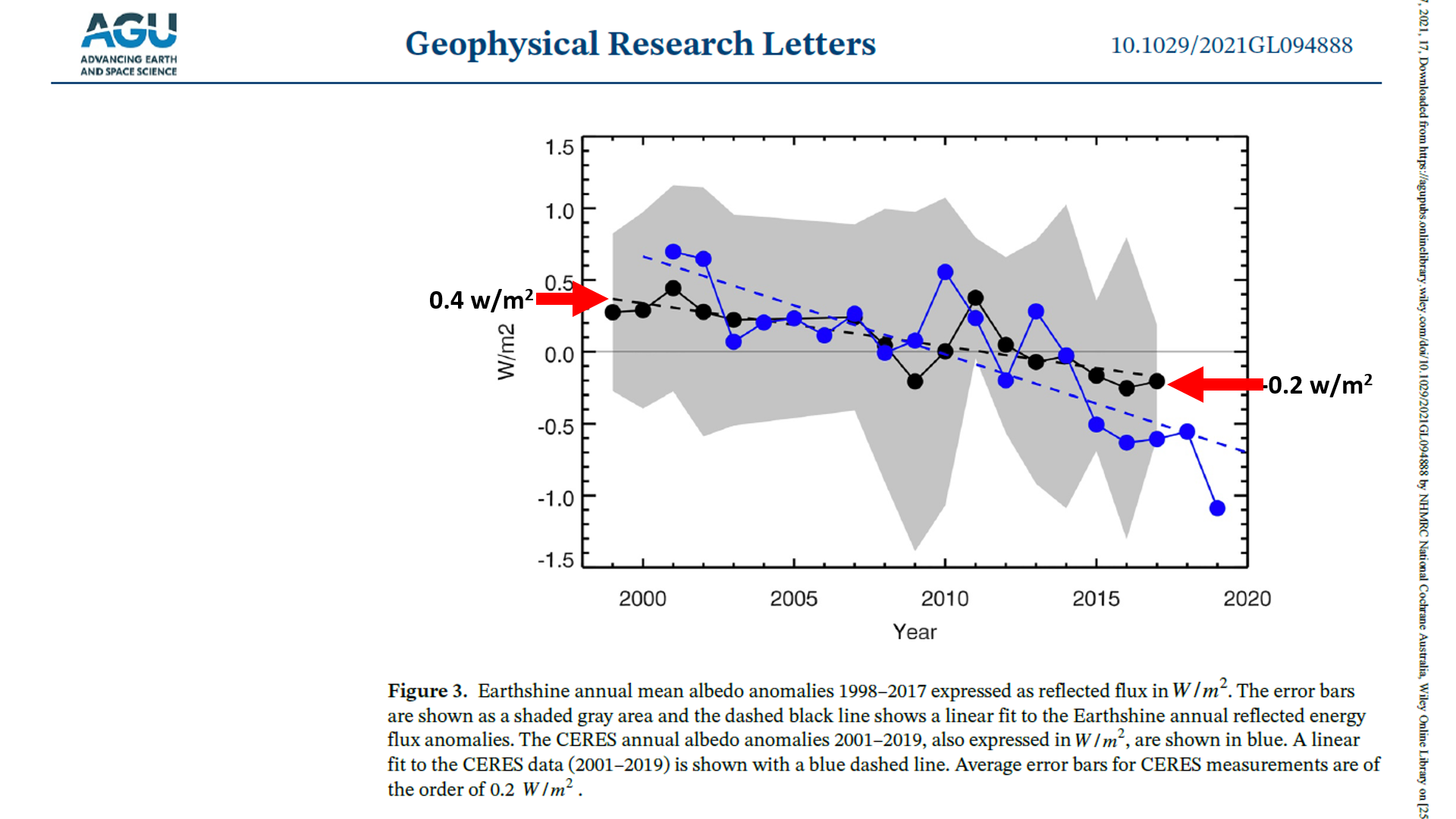
rob...@rtulip.net
Hi John
Great summary.
Here are my suggestions.
Robert
From: noac-m...@googlegroups.com <noac-m...@googlegroups.com> On Behalf Of John Nissen
Sent: Wednesday, 7 December 2022 9:24 AM
To: Robert Tulip <rob...@rtulip.net>
To view this discussion on the web visit https://groups.google.com/d/msgid/noac-meetings/CACS_FxpAKiJsyNEn5eCrTQt4MMwuBngRFviPT9oLKprK1C3o7A%40mail.gmail.com.
Douglas Grandt
With the current datasets, it is striking how well the inter-annual earthshine anomalies agree with those from CERES, and that both show a downturn in the most recent years, even though they cover slightly different parts of the Earth. For the earthshine data, the albedo has decreased by about 0.5
Douglas Grandt
With the current datasets, it is striking how well the inter-annual earthshine anomalies agree with those from CERES, and that both show a downturn in the most recent years, even though they cover slightly different parts of the Earth. For the earthshine data, the albedo has decreased by about 0.5 W/m2, and the decrease is significant (at the 5 x 10^-5 level), while for CERES data, 2001–2017, the decrease of about 1.5 W/m2 is significant at the level of 0.06.
On Dec 7, 2022, at 3:30 PM, 'Douglas Grandt' via Healthy Planet Action Coalition (HPAC) <healthy-planet-...@googlegroups.com> wrote:
Robert and John,Glad to see the Earth's Albedo 1998–2017 as Measured From Earthshine paper (Bit.ly/AGU29Aug21) being used in this effort, but I am unclear as to whether it is additive to or included in the conventional wisdom of GHG GWF.The following excerpt from section 3.3 Earthshine-CERES Comparison led me to conclude simply that there is a difference in the measurements, but that the absolute quantities are both “significant” with different levels of confidence (I may be misinterpreting the meaning of “level”).
With the current datasets, it is striking how well the inter-annual earthshine anomalies agree with those from CERES, and that both show a downturn in the most recent years, even though they cover slightly different parts of the Earth. For the earthshine data, the albedo has decreased by about 0.5 W/m2, and the decrease is significant (at the 5 x 10^-5 level), while for CERES data, 2001–2017, the decrease of about 1.5 W/m2 is significant at the level of 0.06.
Frankly, I don’t know how to restate that in simple English (laymen’s terms). We need a scientist to weigh in.My only suggestion was that increasing albedo by the amount it has been reduced should be a no-brainer argument for Solar Radiation Management [of some kind] in the face of the wide spread anti-geoengineering [emotional] sentiment.That was the intended message to my Ulster County (New York) audience when I present the May Day series of slides on this.I think John could justifiably insert a bullet point expressing restoration of albedo as an imperative using the paper as a reference. It seems to this layman that reducing fossil fuel combustion through decarbonization will further reduce albedo enhancing aerosols, and this should be in future deliberations.Best,
DougSent from my iPhone (audio texting)
On Dec 7, 2022, at 7:52 AM, Rob...@rtulip.net wrote:
Hi John
Planetary insolation averages 341 w/m2 of which about 100 w/m2 is reflected back to space, due to planetary albedo of 0.3 (source).
That means at planetary scale the percentage loss of albedo equals the loss in watts per square metre.
The chart below shows planetary albedo loss trend of 0.6 w/m2 (0.6%) this century from Earthshine data, and 1.4 w/m2 (1.4%) from satellite data (CERES). (source)
Pistone et al found that the Arctic planetary albedo decreased from 0.52 to 0.48 between 1979 and 2011, corresponding to an additional 6.4 ± 0.9 W/m2 of solar energy input into the Arctic Ocean region since 1979. Averaged over the globe, this albedo decrease corresponds to a forcing that is 25% as large as that due to the change in CO2 during this period.
Robert
From: John Nissen <johnnis...@gmail.com>
Sent: Monday, 5 December 2022 5:29 AM
To: peterlin...@gmail.com
Cc: rob...@rtulip.net; Planetary Restoration <planetary-...@googlegroups.com>; NOAC <noac-m...@googlegroups.com>; healthy-planet-action-coalition <healthy-planet-...@googlegroups.com>; Peter Wadhams <peterw...@gmail.com>; Gernot Wagner <Ger...@gwagner.com>; Rafe Pomerance <rafe.po...@gmail.com>; Shaun Fitzgerald <sd...@cam.ac.uk>
Subject: Re: [prag] Arctic Sea Ice Minimum 2022
Hi Peter L.,
Peter Wadhams estimates that albedo loss since 1980 amounts to a climate forcing of around 1.0 W/m2 globally averaged, assuming as much contribution from snow retreat as sea ice retreat. This PNAS paper [1] expresses albedo loss in % per decade of 1.5 with the satellite data, App-x, see figure 1. But this is just over the Arctic. This percentage needs to be translated to W/m2 in order to determine the climate forcing.
The paper also suggests that loss of albedo through black carbon and dust is not a significant factor, though this may have changed with the increase in wildfires and tundra fires. And the paper suggests the albedo loss from snow is greater than from sea ice.
The forcing is an important factor for knowing how much SRM cooling might be required for refreezing the Arctic. It might even rule out MCB as having insufficient cooling power at its maximum possible strength.
Cheers, John
[1] Zhang et al. 2019
https://www.pnas.org/doi/full/10.1073/pnas.1915258116
On Sun, Dec 4, 2022 at 4:09 AM <peterlin...@gmail.com> wrote:
It’s perhaps not as obvious from the graphic, but the NASA figures indicate that although “only” the 10th lowest area, this summer’s coverage has fallen to 75% of the average for the 30 years to 2010. A reduction of 25% in 12 years is striking – and given the pre-1980 warming, this 30 year average is presumably a smaller area of coverage than a century ago.
Peter
From: planetary-...@googlegroups.com <planetary-...@googlegroups.com> On Behalf Of rob...@rtulip.net
Sent: Sunday, 4 December 2022 1:46 PM
To: 'Planetary Restoration' <planetary-...@googlegroups.com>; NOAC <noac-m...@googlegroups.com>; 'healthy-planet-action-coalition' <healthy-planet-...@googlegroups.com>; 'geoengineering' <geoengi...@googlegroups.com>
Subject: [prag] Arctic Sea Ice Minimum 2022
2022 Arctic sea ice minimum, compared to average 1980-2010.
Clear picture of albedo loss. All the blue inside the yellow line used to be white.
https://climate.nasa.gov/news/3213/2022-arctic-summer-sea-ice-tied-for-10th-lowest-on-record/
--
Robert Tulip
--
You received this message because you are subscribed to the Google Groups "Planetary Restoration" group.
To unsubscribe from this group and stop receiving emails from it, send an email to planetary-restor...@googlegroups.com.
To view this discussion on the web visit https://groups.google.com/d/msgid/planetary-restoration/01cd01d9078a%2487f1c3b0%2497d54b10%24%40rtulip.net.--
You received this message because you are subscribed to the Google Groups "Planetary Restoration" group.
To unsubscribe from this group and stop receiving emails from it, send an email to planetary-restor...@googlegroups.com.
To view this discussion on the web visit https://groups.google.com/d/msgid/planetary-restoration/026a01d90796%243868a050%24a939e0f0%24%40gmail.com.
You received this message because you are subscribed to the Google Groups "Planetary Restoration" group.
To unsubscribe from this group and stop receiving emails from it, send an email to planetary-restor...@googlegroups.com.
To view this discussion on the web visit https://groups.google.com/d/msgid/planetary-restoration/058f01d90a3a%24c48c72e0%244da558a0%24%40rtulip.net.
John Nissen
John Nissen
Rebecca Bishop
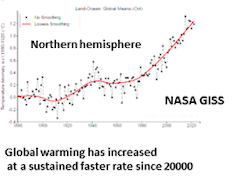
You received this message because you are subscribed to the Google Groups "Planetary Restoration" group.
To unsubscribe from this group and stop receiving emails from it, send an email to planetary-restor...@googlegroups.com.
To view this discussion on the web visit https://groups.google.com/d/msgid/planetary-restoration/CACS_FxpfyeYS3srMPu0%2BZYvrj-C-bE4yUNcSBEBTaxB6Oubqig%40mail.gmail.com.
Ye Tao
John Nissen
Just to note that it needs punctuation at the end of line 2 or it reads as if extreme weather will refreeze the Arctic.
Mike
To view this discussion on the web visit https://groups.google.com/d/msgid/planetary-restoration/CA%2BKfrk2UFrr1B-dwUa5JpPnUM%2Bsab%3DxG7tSm6bTDt5y0Th3OkQ%40mail.gmail.com.
Douglas Grandt
On Dec 8, 2022, at 10:02 AM, John Nissen <johnnis...@gmail.com> wrote:
Hi Mike,I hope you approve of the scientific case we are making for refreezing the Arctic as a top priority for climate action.Re haiku, try this, keeping the 5,7,5 structure and with a crucial colon which implies fulfilment (of the reversal in this case):Reverse climate changeAs weather extremes worsen:Refreeze the ArcticThe "as" could mean "while" or "because", both of which are appropriate; so I don't think the slight ambiguity matters.As for Rebecca's comment on SAI, the scientists need to reassure the public and policy makers that SAI, injected at high latitude in late spring and early summer, has minimal risks from ozone depletion and winter warming: the main scientific concerns. With its blanket cooling effect, the only noticeable thing for people below will be slightly lower temperatures, slightly brighter sunsets and slightly less skin cancer. The restoration of sea ice will have major benefits for wildlife and the way of life for indigenous people.Cheers, John
On Thu, Dec 8, 2022 at 1:02 PM Michael MacCracken <mmac...@comcast.net> wrote:
Just to note that it needs punctuation at the end of line 2 or it reads as if extreme weather will refreeze the Arctic.
Mike
On 12/8/22 1:13 AM, Rebecca Bishop wrote:
Hello John and all,
Thanks for the great work summarising things for the AGU (American Geophysical Union) conference soon.
On a light note, I've added one word / syllable to John's Haiku:
Refreeze the Arctic!Reverse climate changeElse ever worse weather extremes
On a more serious note, John, I could not see in either the policy or scientific summary any comment on the plan to minimise the effects of SAI by doing it at a certain time of year, so it can disperse, and minimise adverse impacts on nations close to the arctic.
I've seen this in one of the threads, and I think it should be included, which I have marked up in the attached edit to v4.
Also, on the poster in this thread I found an acronym (NOAA) which wasn't clear, and also a typo below 20000, when it should be 2000.
To view this discussion on the web visit https://groups.google.com/d/msgid/planetary-restoration/CACS_Fxq7o06hiqBowbB8RfdXKwzXM7hLHEEXVrG4ejL87uxKMA%40mail.gmail.com.
John Nissen
rob...@rtulip.net
Hi John
I have uploaded both documents at https://planetaryrestoration.net/articles-1
Here are the file links
Regards
Robert

